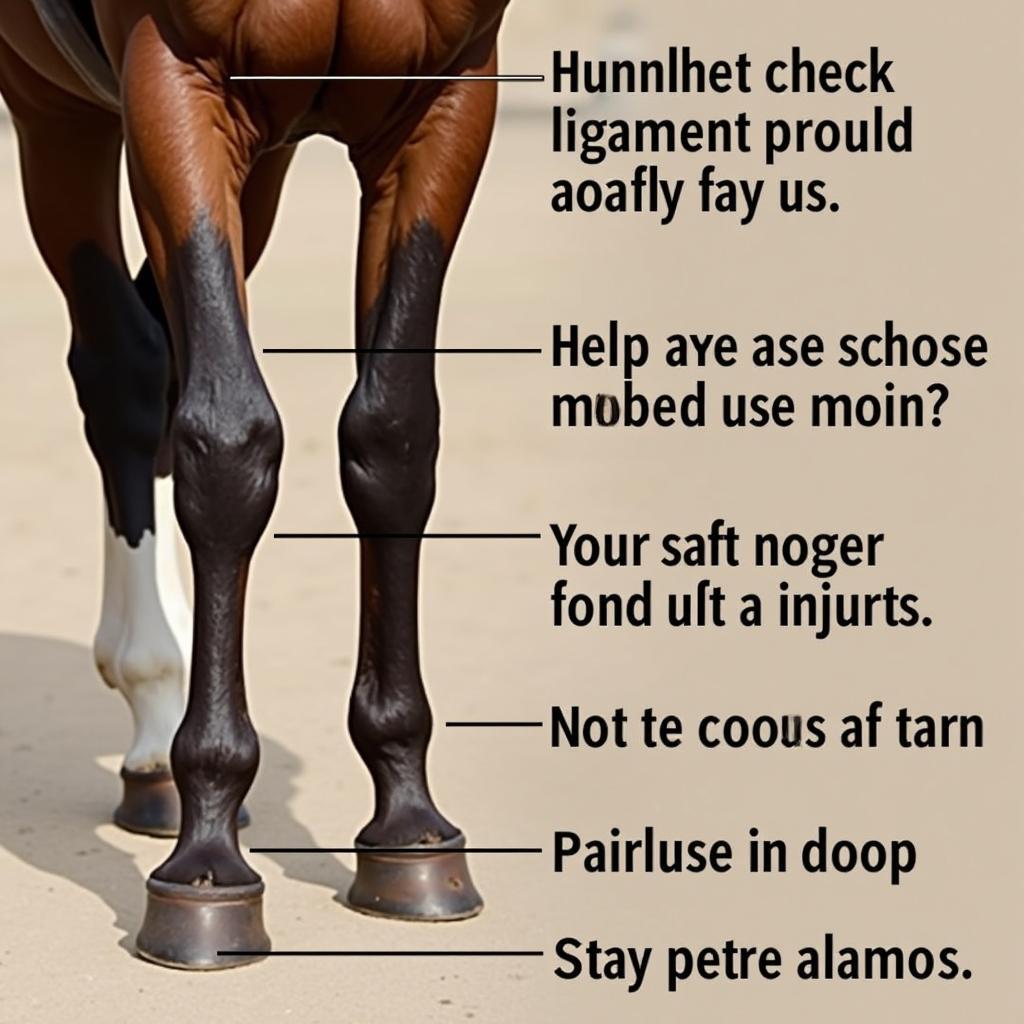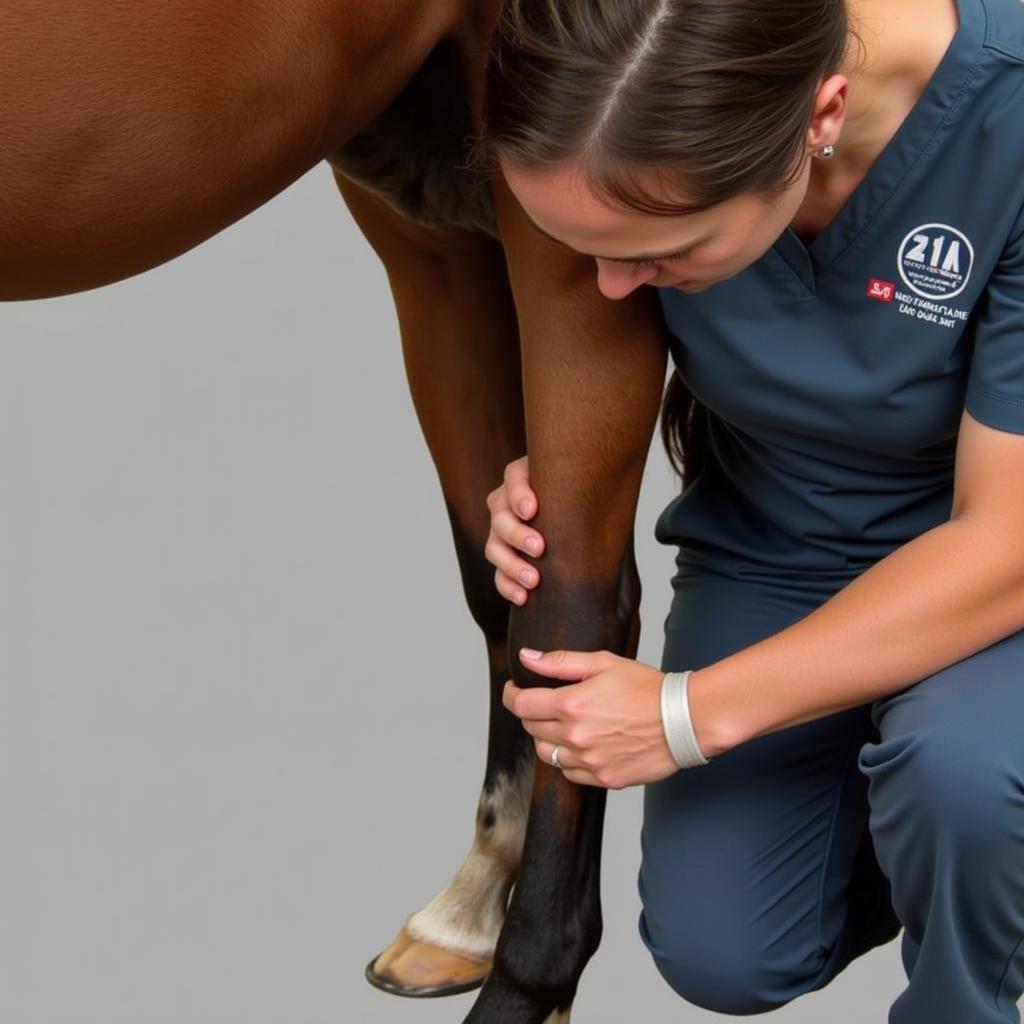The inferior check ligament (ICL) plays a vital role in the intricate mechanics of a horse’s leg, specifically within the lower limb. This ligament acts as a crucial support structure for the deep digital flexor tendon (DDFT), which is responsible for flexing the digit (hoof) and supporting the fetlock joint.
The Function of the Inferior Check Ligament in Horses
The inferior check ligament, despite its relatively small size, plays a significant role in supporting the horse’s weight and facilitating movement. It acts as a “brake” for the deep digital flexor tendon, preventing excessive strain and overextension of the fetlock joint, particularly during high-speed activities such as running and jumping. The ICL also helps to stabilize the DDFT, ensuring that it functions efficiently and transmits force effectively during locomotion.
Common Issues with the Inferior Check Ligament in Horses
Injuries to the inferior check ligament, though not as common as other tendon and ligament injuries in horses, can significantly impact a horse’s performance and soundness.
- Inferior Check Ligament Desmitis: This refers to inflammation of the ligament, often caused by repetitive strain or trauma.
- Inferior Check Ligament Rupture: A complete or partial tear of the ligament, often resulting from severe trauma or chronic degeneration.
 Horse Leg with Inferior Check Ligament Injury
Horse Leg with Inferior Check Ligament Injury
Recognizing Inferior Check Ligament Problems
Recognizing the signs of an ICL injury is crucial for prompt diagnosis and treatment. Common symptoms include:
- Lameness: Varying degrees of lameness, often more pronounced during exercise.
- Swelling: Noticeable swelling around the palmar (back) aspect of the fetlock joint.
- Heat: Increased temperature in the affected area.
- Pain: Discomfort or pain on palpation of the ligament.
- Altered Gait: A shortened stride, reluctance to extend the leg fully, or a “toe-dragging” gait.
Diagnosing and Treating Inferior Check Ligament Injuries
Veterinarians typically employ a combination of methods to diagnose ICL injuries:
- Physical Examination: Assessing the horse’s lameness, palpating the ligament, and evaluating range of motion.
- Ultrasound: Using sound waves to create images of the ligament, allowing visualization of any tears or damage.
- X-rays: To rule out other potential causes of lameness, such as fractures.
Treatment options for ICL injuries depend on the severity and nature of the injury:
- Conservative Management: Rest, cold therapy, anti-inflammatory medications, and controlled exercise are often the first line of treatment for mild strains or inflammation.
- Regenerative Therapies: Techniques like platelet-rich plasma (PRP) or stem cell therapy may be used to promote healing.
- Surgery: In severe cases, such as complete ligament ruptures, surgical intervention may be necessary to repair or reconstruct the ligament.
 Veterinarian Examining a Horse's Leg
Veterinarian Examining a Horse's Leg
Long-Term Management and Prevention
Following veterinary recommendations for rehabilitation is essential for optimal healing and return to function after an ICL injury. Long-term management may involve:
- Controlled Exercise Program: Gradual reintroduction of exercise to strengthen the ligament and surrounding structures.
- Corrective Shoeing: Specific shoeing techniques can help to reduce strain on the ligament.
- Supportive Bandaging: Providing support and stability to the fetlock joint during the healing process.
Prevention strategies focus on minimizing risk factors for ICL injuries:
- Proper Conditioning: Ensuring horses are adequately conditioned for their level of activity.
- Good Footing: Providing safe and even footing to reduce the risk of slips and strains.
- Regular Veterinary Check-ups: Early detection and management of any lameness issues can help prevent more serious injuries.
Conclusion
The inferior check ligament, though small, plays a critical role in the biomechanics of a horse’s leg. Understanding its function, recognizing potential problems, and seeking prompt veterinary care are crucial for maintaining equine athleticism and well-being. By prioritizing preventative measures and working closely with your veterinarian, you can help keep your equine partner sound and performing at their best.
Need Assistance?
For personalized guidance and support with your horse’s health, contact our dedicated team at:
Phone Number: 0772127271
Email: [email protected]
Address: QGM2+WX2, Vị Trung, Vị Thuỷ, Hậu Giang, Việt Nam.
Our customer care team is available 24/7 to assist you.